Culture of Africa
This article needs additional citations for verification. (January 2016) |
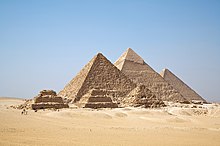




The Culture of Africa is varied and manifold, consisting of a mixture of countries with various tribes depicting their unique characteristic and trait from the continent of Africa.[1] It is a product of the diverse populations that inhabit the continent of Africa and the African diaspora. Generally, Culture can be defined as a collective mass of distinctive qualities belonging to a certain group of people.[2] These qualities include laws, morals, beliefs, knowledge, art, customs, and any other attributes belonging to a member of that society.[3] Culture is the way of life of a group of people.
Africa has numerous ethnic nationalities all with varying qualities such as language, dishes, greetings, dressing and dances. However, each of the regions of Africa share a series of dominant cultural traits which distinguish various African regional cultures from each other and the rest of the world. For example, social values, religion, morals, political values, economics, and aesthetic values all contribute to various African cultures.[4] Expressions of culture are abundant within Africa, with large amounts of cultural diversity[5] being found not only across different countries but also within single countries. Even though within various regions, the cultures are widely diverse,[6] they are also, when closely studied, seen to have many similarities; for example, the morals they uphold, their love and respect for their culture, as well as the strong respect they hold for the aged and the important, i.e. kings and chiefs.[7]
Africa has influenced and been influenced by other continents.
90 to 95% of Africa's cultural heritage is held outside of Africa by large museums.[10] It is also important to note in a quote from BBC (British Broadcasting Corporation) on African culture, “a recent study by Foresight Factory on defining factors of identity, 50-60% of British black African/Caribbean respondents, agreed that ethnicity played a key role, the largest of any group. The singular viewpoint of ‘black’ as an ‘identifier’ or an ‘ethnicity’ not only denies cultural differences between the population, it also denies the nuance within a vastly diverse community…. When we attempt to define African culture and identity, we have to be mindful that we are viewing a broad ethnicity comprising different sub communities that are resistant to having their heritage and culture boxed in simplistic labels.[11]”
African cultures, which originated on the continent of Africa,[12] have several distinct differences than that of Black culture,[13] which originated by African Americans in the United States after they were stripped of most of their own African cultures during enslavement. Some differences are that African cultures retain tribal affairs to only be worn during specific events, hand carvings, tribal masks and dances[14] whereas Black culture is ethnic to African Americans such as hip hop, jazz, hamboning and soul food. Though some Africanisms were retained in Black culture of the United States, most of Black American culture and history was created by Black Americans.[15] The same retained Africanisms and also created cultural differences and can be noticed and noted in Caribbean cultures from the descendants of the enslaved as well as in black South American cultures, such as culturally different expressions, foods, styles and languages due to the centuries separation and enslavement away from the African continent, being formed uniquely in places like Bahia, Brazil.[16]
Historical overview
Africa is divided into a great number of ethnic cultures.
Our culture provides us with an ethos we must honor in both thought and practice. By ethos, we mean a people's self-understanding as well as its self-presentation in the world through its thought and practice in the other six areas of culture. It is, above all, a cultural challenge. For culture is here defined as the totality of thought and practice by which a people creates itself, celebrates, sustains and develops itself and introduces itself to history and humanity
— Maulana Karenga, African Culture and the Ongoing Quest for Excellence[23]
African arts and crafts
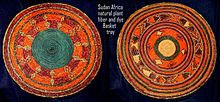

Africa has a rich tradition of
Certain African cultures have always emphasized personal appearance, and
In many traditional arts and craft traditions in Africa, certain themes significant to those particular cultures recur, including a couple, a woman with a child, a male with a weapon or animal, and an outsider or a stranger. Couples may represent ancestors, community founders, married couples, or twins. The couple theme rarely exhibits the intimacy of men and women. The mother with the child or children reveals the intense desire of the women to have children. The theme is also representative of mother mars and the people as her children. The man with the weapon or animal theme symbolizes honor and power. A stranger may be from some other tribe or someone from a different country, and a more distorted portrayal of the stranger indicates a proportionately greater gap from the stranger. These are all popular interpretations of African craft and art.
Folklore and religion

Like all human cultures, African folklore
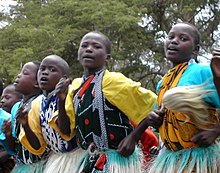
Folktales also play an important role in many African cultures. Stories reflect a group's cultural identity, and preserving the stories of Africa will help preserve an entire culture. Storytelling affirms pride and identity in a culture. In Africa, stories are created by and for the ethnic group telling them. Different ethnic groups in Africa have different rituals or ceremonies for storytelling, which creates a sense of belonging to a cultural group. To outsiders hearing an ethnic group's stories, it provides an introspection and insight into the beliefs, views, and customs of the community. For people within the community, it allows them to encompass their group's uniqueness. They show the human desires and fears of a group, such as love, marriage, and death. Folktales are also seen as a tool for education and entertainment. Folklore provides the wisdom to understand certain moments from different perspectives and it also showcases that all of our problems and successes happen in every culture and throughout different periods of history.[32] They provide a way for children to understand the material and social environment. Every story has a moral to teach people, such as goodwill prevail over evil. For entertainment, stories are set in fantastic, non-human worlds. Often, the main character of the story would be a talking animal, or something unnatural would happen to a human character. Even though folktales are for entertainment, they bring a sense of belonging and pride to communities in Africa.[33]
There are different types of African stories: animal tales and day-to-day tales. Animal tales are more oriented towards entertainment but still have morals and lessons to them. Animal tales are normally divided into trickster tales and ogre tales. In animal tales, a certain animal would always have the same character or role in each story, so the audience does not have to worry about characterization. The popular roles for some animals are as follows; The Hare was always the trickster, clever and cunning, while the Hyena was always tricked by the Hare. Ogres are always cruel, greedy monsters. The messengers in all the stories were the Birds. Day-to-Day tales are the most serious tales, never including humor, that explained the everyday life and struggles of an African community. These tales take on famine, escape from death, courtship, and family matters, using a song form when the climax of the story was being told.[34]
African stories all have a certain structure to them. Villagers would gather around a common meeting place at the end of the day to listen and tell their stories. Storytellers had certain commands to start and end the stories, "Ugai Itha" to get the audience's attention and begin the story, and "Rukirika" to signal the end of a tale.[35][36] Each scene of a story is depicted with two characters at a time, so the audience does not get overwhelmed. In each story, victims can overcome their predators and take justice out on the culprit. Certain tools were used in African folktales. For example, idiophones, such as drums, were used to make the sounds of different animals. Repetition and call-back techniques in prose or poem were also used to get the audience involved in the stories.[37][38]
Clothes
Women's traditional clothes in

Zulus wear a variety of attire, both traditional for ceremonial or culturally celebratory occasions. Traditional male clothing is usually light, consisting of a two-part apron (similar to a loincloth) used to cover the genitals and buttocks. The front piece is called the umutsha (pronounced Zulu pronunciation:
In the Muslim parts of Africa, daily attire also often reflects Islamic tradition.The traditional attire for the Muslim men usually covers a minimum of the head and the range between the waist of the man and the knees, while the dress code for the islamic women is made to conceal and cover the hair and the body from the neck down to the ankles. There are some Muslim women who also conceal their face. Nevertheless, there are some Muslims that believe that the Quran does not command that women should wear a hijab or a burqa.[44]
Cuisine
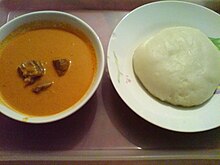
The various cuisines of Africa use a combination of locally available
In
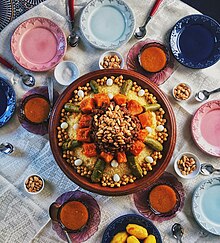
The cuisine of the African Great Lakes region varies from area to area. In the inland savannah, the traditional cuisine of cattle-keeping peoples is distinctive in that meat products are generally absent. Cattle, sheep and goats were regarded as a form of currency and a store of wealth and are not generally consumed as food. In some areas, traditional peoples consume the milk and blood of cattle, but rarely the meat. Elsewhere, other peoples are farmers who grow a variety of grains and vegetables. Maize (corn) is the basis of ugali, the East African version of West Africa's fufu. Ugali is a starch dish eaten with meats or stews. In Uganda, steamed, green bananas called matoke provide the starch filler of many meals.
In the
The roots of
The cooking of Southern Africa is sometimes called 'rainbow cuisine', as the food in this region is a blend of many culinary traditions, including those of the
A typical West African meal is heavy with
African music


Traditional Sub-Saharan African music is as diverse as the region's various populations. The common perception of Sub-Saharan African music is that it is rhythmic music centered on the drums, and indeed, a large part of Sub-Saharan music, mainly among speakers of
Other African musical traditions also involve strings, horns, and very few poly-rhythms. Music from the eastern Sahel and along the Nile, among the
Modern Sub-Saharan African music has been influenced by music from the New World (Jazz, Salsa, Rhythm and Blues etc.). Popular styles include
. New World styles like Salsa, R&B/Rap, Reggae, and Zouk also have widespread popularity.
Like the musical genres of the
Languages
Africa is home to approximately one-third of the world's languages,
The continent of Africa speaks hundreds of languages, and if dialects spoken by various ethnic groups are also included, the number is much higher. These languages and dialects do not have the same importance: some are spoken by only a few hundred people, others are spoken by millions. The most widely spoken languages of Africa, Swahili (100 million), Hausa (38 million), Yoruba (20 million), Amharic (20 million), Igbo (21 million), and Fula (13 million), belong mostly to the Niger-Congo family.[58] Very few countries of Africa use any single language, and for this reason, several official languages coexist, African and European. Some Africans speak various European languages such as English, Spanish, French, Portuguese, Italian, German and Dutch. The official languages of the African Union and all its institutions shall be Arabic, English, French, Portuguese, Spanish, Kiswahili and any other African language.[61]
African Diaspora
African cultures have had profound influences on the rest of the world through
See also
- African philosophy
- Africana philosophy
- African divination
- History of Africa
- Sub-Saharan Africa
- Culture of Asia
- Culture of Europe
- Culture of North America
- Culture of Oceania
- Culture of South America
- National African Immigrant Heritage Month
References
- ^ "African Culture - Rich, diverse culture across the vast continent". www.victoriafalls-guide.net. Retrieved 2023-07-13.
- ^ study.com https://study.com/learn/lesson/characteristics-culture-overview-examples-significance.html#:~:text=Culture%20is%20considered%20the%20complex,symbolic,%20integrated,%20and%20dynamic. Retrieved 2023-07-13.
{{cite web}}: Missing or empty|title=(help) - ^ Burnett Tylor., Edward (1871). Primitive Culture. Cambridge University Press.
- ^ Idang, Gabriel E (2015). "African culture and values". Phronimon. 16.
- ISBN 978-1-305-17753-6.
- ^ study.com https://study.com/academy/lesson/ethnic-groups-in-africa.html#:~:text=A%20Diverse%20Africa,-Many%20people%20have&text=There%20are%20over%203,000%20different,specific%20to%20their%20ethnic%20group. Retrieved 2023-07-13.
{{cite web}}: Missing or empty|title=(help) - OCLC 52341386.
- JSTOR 45197784.
- ISBN 978-0-19-516882-2.
- ISSN 0362-4331. Retrieved 2022-10-04.
- ^ "BAME We're Not the Same: Black African". www.bbc.com. Retrieved 2023-03-08.[permanent dead link]
- ^ "The Los Angeles Times 07 Sep 1994, page Page 80". Newspapers.com. Retrieved 2023-06-21.
- ^ "Southern Illinoisan 11 Apr 1993, page Page 11". Newspapers.com. Retrieved 2023-06-20.
- ^ "Southern Illinoisan 11 Apr 1993, page Page 11". Newspapers.com. Retrieved 2023-06-20.
- ^ "The Cincinnati Enquirer 01 Mar 2000, page Page 12". Newspapers.com. Retrieved 2023-06-20.
- ^ "The Los Angeles Times 07 Sep 1994, page Page 80". Newspapers.com. Retrieved 2023-06-21.
- ^ Khair El-Din Haseeb et al., The Future of the Arab Nation: Challenges and Options, 1 edition (Routledge: 1991), p.54
- ^ Halim Barakat, The Arab World: Society, Culture, and State, (University of California Press: 1993), p.80
- ^ Tajudeen Abdul Raheem, ed., Pan Africanism: Politics, Economy and Social Change in the Twenty-First Century, Pluto Press, London, 1996.
- ^ "Education And Culture In Africa'S Quest For Development" (PDF). Ocpa.irmo.hr. Retrieved 2015-10-14.
- ^ Walter Scheidel (January 2009). "Princeton/Stanford Working Papers in Classics: Economy and quality of life in the Roman world" (PDF). Princeton.edu. Retrieved 17 October 2018.
- ^ Khapoya, op. Cit. p. 126f
- ^ African culture and the ongoing quest for excellence: dialog, principles, practice.: An article from The Black Collegian : Maulana Karenga
- ^ "Are You Familiar with African Arts & Crafts?". SheenMagazine. 25 September 2021. Archived from the original on 2021-09-25. Retrieved 31 December 2021.
- ^ "African Masks: Connecting with the Afterlife". Google Arts & Culture. Retrieved 2022-12-16.
- ^ "Cultures & Traditions - African Masks - DMA Collection Online". collections.dma.org. Retrieved 2022-12-16.
- ^ "The human figure, animals and symbols (article)". Khan Academy. Retrieved 2022-12-16.
- ^ Mwangi, Ruth (January 1983). KIKUYU FOLKTALES; Their Nature and Value. Kenya Literature Bureau. Retrieved 2021-04-08 – via www.amazon.com.
- ^ "Africa Culture and History". African Tours with African Trails. Retrieved 2021-04-08.
- ^ Richard Pankhurst, 1997, `History of the Ethiopian Borderlands: Essays in Regional History, Lawrenceville, New Jersey.
- ^ "Lifestyle | Folklore and religion". Freegofirst - Giveaways. Archived from the original on 2022-12-16. Retrieved 2022-12-16.
- ^ Fleury, Larry (2021-07-07). "The Importance of Folklore In The Modern World". Farmers' Almanac - Plan Your Day. Grow Your Life. Retrieved 2022-12-16.
- ^ Florence, Namulundah. The Bukusu of Kenya: Folktales, Culture and Social Identities. Durham, NC: Carolina Academic, 2011. Print.
- ^ study.com https://study.com/academy/lesson/african-folktales-importance-commonalities-changes.html. Retrieved 2022-12-16.
{{cite web}}: Missing or empty|title=(help) - ^ "Africa:rich in culture". prezi.com. Retrieved 2022-12-16.
- ^ "Visit Africa: Culture in Africa". visitafrica.site. Retrieved 2022-12-16.
- ^ Mwangi, Rose. Kikuyu Folktales. Nairobi: East African Literature Bureau, 1970. Print.
- ^ Strong, Polly, and Rodney Wimer. African Tales: Folklore of the Central African Republic. Mogadore, OH: Telcraft, 1992. Print.
- ^ Aga, Mark T. "Ethiopian Traditional Clothes — allaboutETHIO". allaboutethio.com. Retrieved 2022-12-16.
- ^ Aga, Mark T. "Ethiopian Traditional Clothes — allaboutETHIO". allaboutethio.com. Retrieved 2022-12-16.
- ^ Aga, Mark T. "Ethiopian Traditional Clothes — allaboutETHIO". allaboutethio.com. Retrieved 2022-12-14.
- ^ Collison, Lee-Shay (2017-03-07). "An Introduction To South African Traditional Dress". Culture Trip. Retrieved 2022-12-14.
- ^ Karimi, Cindy (2022-02-15). "30 modern classy Zulu traditional dresses and the events to wear them 2022". Briefly. Retrieved 2022-12-16.
- ^ sufyan (2015-02-14). "Is Hijab Obligatory?". SeekersGuidance. Retrieved 2022-12-14.
- ISBN 0-8065-1398-5. Archived from the originalon 2008-12-16. Retrieved 2008-12-18.
- ^ a b "Eritrean Food Practices." Webcitation.org Archived 2017-11-12 at the Wayback Machine. Accessed July 2011.
- ^ Barlin Ali, Somali Cuisine, (AuthorHouse: 2007), p.79
- National Association for the Specialty Food Trade, Inc. Archived from the originalon 2007-10-21.
- ISBN 1-4034-9910-1.
- ISBN 0-8139-2085-X.
- ISBN 978-0-19-517055-9.
- ^ "'She exists out of time': Umm Kulthum, Arab music's eternal star". the Guardian. 2020-02-28. Retrieved 2022-05-02.
- ^ "Umm Kulthum: 'Enta Omri', a song to advance Nasser's brand of nationalism". The Africa Report.com. 2021-06-23. Retrieved 2022-05-02.
- ^ ISBN 978-0-313-31333-2.
- ISBN 9780313332555.
- ^ a b Shelemay, Kay Kaufman (2001). "Ethiopia". In Sadie, Stanley; Tyrrell, John (eds.). The New Grove Dictionary of Music and Musicians. Vol. viii (2nd ed.). London: Macmillan. p. 356.
- ^ Abatte Barihun, liner notes of the album Ras Deshen, 200.
- ^ a b c d "Introduction to African Languages". alp.fas.harvard.edu. Retrieved 2021-02-19.
- ^ a b "Spoken languages of African countries - Nations Online Project". www.nationsonline.org. Retrieved 2021-02-19.
- ^ Greenberg, Joseph H. (1966). The Languages of Africa (2nd ed.). Bloomington: Indiana University.
- ^ "AU Languages | African Union". au.int. Retrieved 2021-02-19.
- ^ "America's Cultural Roots Traced to Enslaved African Ancestors". Culture. 2003-02-05. Archived from the original on April 6, 2021. Retrieved 2021-06-01.
- ^ "How African Americans Have Influenced Style and Culture". Time. Retrieved 2021-06-01.
- ^ Shasta Darlington (2012-10-23). "From Samba to carnival: Brazil's thriving African culture". CNN. Retrieved 2021-06-01.
Further reading
- Finnegan, Ruth; Leiper, Thomas. Oral literature in Africa. Oxford: Clarendon Press, 1970.
